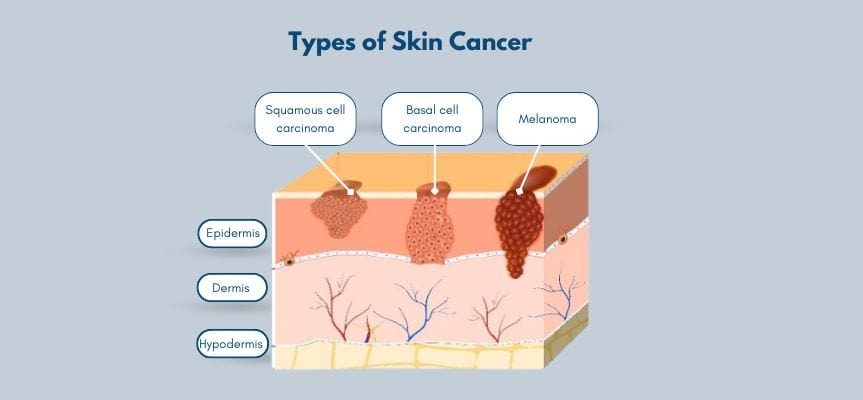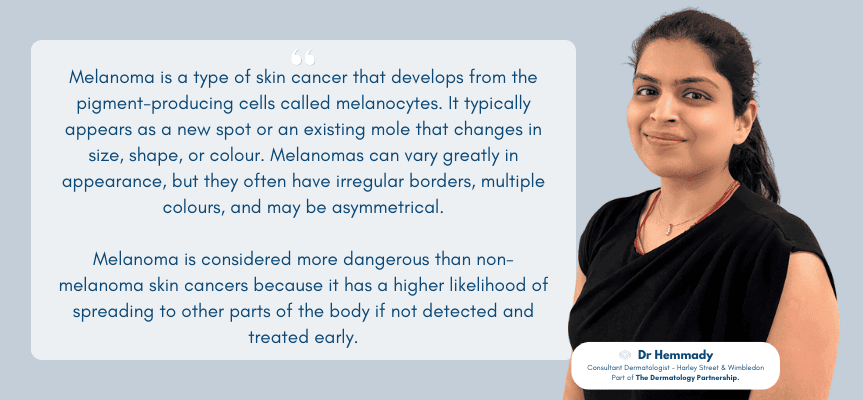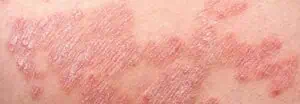May is not just a month of blooming flowers and warm weather—it’s a time of heightened vigilance against a silent but deadly foe to our skin health. Melanoma Awareness Month is an annual clarion call, not only for cancer survivors but for all of us to champion the prevention and early detection of melanoma, the most lethal form of skin cancer. This comprehensive blog post will give you knowledge and practical steps to protect yourself and your loved ones.
Understanding Melanoma
Melanoma is a type of skin cancer originating from melanocytes, the pigment-producing cells in our skin. It may begin as a new lesion or a change in an existing mole. What makes melanoma particularly dangerous is its tendency to spread rapidly to other parts of the body if not caught early. Despite accounting for a small percentage of skin cancer cases, melanoma leads the statistics in skin cancer-related deaths.

Numbers that Matter
Melanoma Risk Assessment
Several factors can increase an individual’s likelihood of developing melanoma. These include:
- UV Exposure: Sunburns and repeated exposure to UV radiation are significant risk factors for melanoma, especially in childhood and adolescence.
- Genetic Predisposition: Certain genetic mutations can increase susceptibility to skin cancers, including melanoma.
- Fair Skin: People with fair skin, particularly those with red or blonde hair, have a higher risk due to reduced natural protection from UV rays.
- Mole Count and Type: Individuals with numerous moles or atypical mole patterns are at an increased risk.
Types of Melanoma
Melanoma presents in various forms, each with unique characteristics and treatment complexities:
- Superficial Spreading Melanoma: The most common form, often appearing in the early stages on the skin’s surface.
- Nodular Melanoma: A rapidly invasive form that appears as a raised bump, often black.
- Lentigo Maligna Melanoma: Commonly found in older adults, it often starts as a lentigo maligna on the face or ears.
- Acral Lentiginous Melanoma: This type is often found on the palms of the hands, soles of the feet, or under the nails and is not related to UV exposure.
Early Detection: A Lifesaver
In melanoma, as with many forms of cancer, timing is everything. Catching the disease in its initial stages can result in a nearly 100% survival rate. However, when left to progress, those odds plummet dramatically.
The ABCDEs of Melanoma
Familiarising yourself with these simple yet crucial guidelines could potentially save your life:
- A for Asymmetry: When one half of a mole does not match the other.
- B for Border Irregularity: The edges of a mole are notched, scalloped, or indistinct.
- C for Colour: The mole’s colour isn’t uniform or inconsistent, with shades of tan, brown, black, red, white, or blue.
- D for Diameter: Any mole larger than a pencil eraser should be monitored.
- E for Evolving: Look for moles that change in size, shape, or colour over time.
The Path to Diagnosis
The series of steps from self-examination to seeking professional assessment is critical:
- Perform regular self-checks, especially if you’re at higher risk.
- Schedule annual skin evaluations with a dermatologist.
- Never ignore concerning changes in your skin’s appearance or any new lesions.

Shielding Your Skin
Safe Sun Practices
- Apply sunscreen with an SPF of at least 30 and broad-spectrum protection on all exposed skin every two hours or more frequently if swimming or sweating.
- Seek shade, especially during midday when the sun’s rays are strongest.
- Wear UV-blocking eyewear, hats, and clothing.
Indoor Tanning: A False Notion of Beauty
Tanning beds and lamps emit UV radiation that can harm the skin and increase the risk of skin cancer, including melanoma. There’s no such thing as a “safe tan.”
The Role of Community in Prevention
Awareness Campaigns
Fundraising and Support
The Future of Melanoma
Advancements in treatment and prevention are on the horizon, and clinical trials are pivotal in shaping that future.
Medical Therapies and Surgery
The Hope of Clinical Trials
Engaging in a clinical trial offers the possibility of earlier access to new treatments and the opportunity to contribute to broader scientific advancements in skin cancer.
Taking a Stand for Your Skin
In closing, your actions can significantly impact your future skin health. By adopting a vigilant attitude towards self-care, actively spreading awareness and supporting the more significant movement, you become a champion against melanoma.
May you use this Melanoma Awareness Month to heighten your knowledge of skin cancer and motivate your community to take collective action. Whether you share this post or sign up for a skin check, your participation strengthens our shared commitment to skin health.
Take charge of your skin today, advocate for melanoma awareness this May and ingrain preventive skin habits that will last a lifetime. Protect your skin – it’s the first line of defence for your overall well-being.Early Detection Saves Lives
Don’t delay—make it a priority to schedule your skin examination this Melanoma Awareness Month. It’s a crucial step in the ongoing effort to reduce melanoma risks and save lives. Your future self will thank you.



